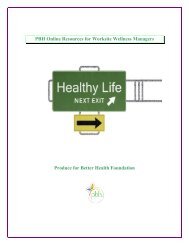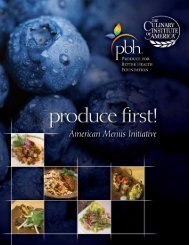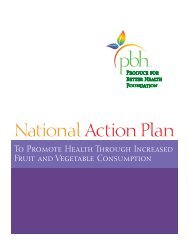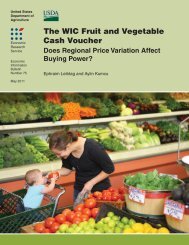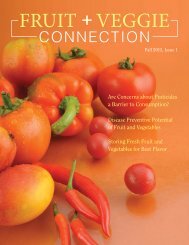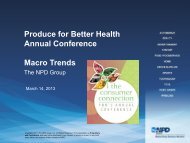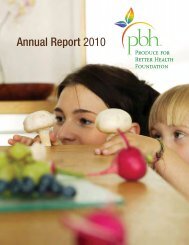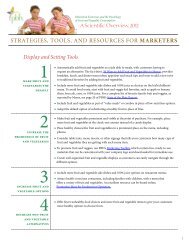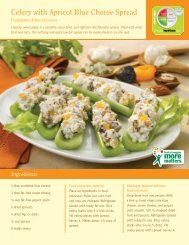Why All Forms Matter Brochure - Produce for Better Health Foundation
Why All Forms Matter Brochure - Produce for Better Health Foundation
Why All Forms Matter Brochure - Produce for Better Health Foundation
You also want an ePaper? Increase the reach of your titles
YUMPU automatically turns print PDFs into web optimized ePapers that Google loves.
Organic is not healthier than<br />
conventionally grown<br />
Organic fruits and vegetables are not more nutritious<br />
than conventionally grown. An analysis of 46<br />
studies published in 2009 determined that “there<br />
is no evidence of a difference in nutrient quality<br />
between organically and conventionally produced<br />
foodstuffs.” The authors reported that a small<br />
number of differences in nutrient content existed<br />
between organically and conventionally produced<br />
foods, but were unlikely to be of public health<br />
relevance. 28<br />
Conventionally grown fruits and vegetables are<br />
safe! The U.S. EPA’s current process <strong>for</strong> evaluating<br />
the potential risks of pesticides on food is rigorous<br />
and health-protective. The EPA’s testing requirements<br />
<strong>for</strong> pesticides used on food are more extensive<br />
than <strong>for</strong> chemicals in any other use category,<br />
and include testing targeted specifically to assess<br />
the potential risks to fetuses, infants, and children.<br />
The 2010 Pesticide Data Program Annual Summary<br />
confirms that pesticide residues in food do not pose<br />
<strong>Health</strong>y foods are not more expensive<br />
When you compare the price of foods by weight or<br />
average portion size, vegetables and fruits are less<br />
expensive than most dairy, protein, and moderation<br />
foods. It’s only when you compare price per calorie<br />
that less healthy foods are cheaper than fruits and<br />
vegetables. 30<br />
a safety concern. Specifically, any residues found in<br />
fruits and vegetables are at levels that do not pose<br />
risk to consumers’ health. 29 This nation’s food supply<br />
continues to be among the safest in the world.<br />
Visit SafeFruitsAndVeggies.com to determine<br />
just how many fruits and vegetables would need<br />
to be consumed to even come close to any<br />
pesticide residues that might be harmful. Also<br />
visit FoodDialogues.com to learn where our<br />
food comes from.<br />
The bottom line? The benefits of eating fruits<br />
and vegetables far outweigh any risks from<br />
pesticide residues! Inadequate consumption<br />
among Americans is the much bigger concern.<br />
So, whether conventionally grown or organic,<br />
the important thing to remember is, the benefits<br />
of eating fruits and vegetables are indisputable.<br />
Getting the recommended amount of fruits and vegetables<br />
costs as little as $2-$2.50 per day. Researchers<br />
found no significant difference between the average<br />
prices of 153 fresh, frozen, canned, and dried fruits<br />
and vegetables. Average prices ranged from under 20<br />
cents to over $2 per edible cup equivalent, depending<br />
on the specific fruit or veggie. 31<br />
Food Miles?<br />
Food miles is a concept relating to the distance<br />
food travels as a measure of its impact<br />
on the environment. This definition only<br />
includes distance food travels and does not<br />
consider total energy use in the production<br />
of the product. Growing a product in its ideal<br />
location with the best production techniques<br />
generally produces the best product with<br />
fewer overall energy inputs.<br />
Locally Grown?<br />
Bananas, oranges, grapefruit, lemons, limes,<br />
mangoes, kiwifruit, cranberries, figs, papayas,<br />
persimmons, dates, jicama, avocados, sweet<br />
cherries, raisins, and artichokes are a<br />
sampling of items that are grown only in a<br />
few U.S. states, if grown in the U.S. at all.<br />
Eat Seasonally?<br />
This is a terrific way to find the best tasting<br />
produce at the best price, but recognize that<br />
a season may only last a few weeks. This<br />
is why preserving foods through canning,<br />
freezing, juicing, or drying helps provide<br />
these same terrific products year-round.<br />
What you can do to help<br />
Consumers need assurance that the most important thing they can do is eat<br />
more fruits and vegetables, regardless of whether they are fresh, canned,<br />
frozen, dried, or 100% juice.<br />
To find tips and ideas on preparing fruits and vegetables in healthful ways, look to<br />
FruitsAndVeggiesMore<strong>Matter</strong>s.org.<br />
For More In<strong>for</strong>mation:<br />
FruitJuiceFacts.org • mealtime.org • FrozenFoodFacts.org • nutfruit.org • PBH<strong>Foundation</strong>.org<br />
REFERENCES<br />
1<br />
National Action Plan to Promote <strong>Health</strong> Through Increased<br />
Fruit and Vegetable Consumption: 2010 Report Card.<br />
<strong>Produce</strong> <strong>for</strong> <strong>Better</strong> <strong>Health</strong> <strong>Foundation</strong>.<br />
http://www.PBH<strong>Foundation</strong>.org.<br />
2<br />
Hyson, Dianne A. Fruits, Vegetables, and <strong>Health</strong>: A<br />
Scientific Overview, 2011. <strong>Produce</strong> <strong>for</strong> <strong>Better</strong> <strong>Health</strong><br />
<strong>Foundation</strong>. http://www.PBH<strong>Foundation</strong>.org.<br />
3<br />
Rickman, J., Barrett, D., and Bruhn, C. Nutritional<br />
comparison of fresh, frozen and canned fruits and<br />
vegetables. Part I. Vitamins C and B and phenolic<br />
compounds. Journal of the Science of Food and Agriculture,<br />
Vol. 87. Issue 6, pp 930-944, 2007, April 2007.<br />
4<br />
Rickman, J., Barrett, D., and Bruhn, C. Nutritional<br />
comparison of fresh, frozen and canned fruits and<br />
vegetables. Vitamin A and carotenoids, vitamin E, minerals<br />
and fiber. Journal of the Science of Food and Agriculture,<br />
Vol. 87. Issue 7, pp 1185-1196, May 2007.<br />
5<br />
<strong>Produce</strong> <strong>for</strong> <strong>Better</strong> <strong>Health</strong> <strong>Foundation</strong>. 2012 Primary<br />
Shoppers/Moms with Kids 10 & Under Study.<br />
http://www.PBH<strong>Foundation</strong>.org.<br />
6<br />
<strong>Produce</strong> <strong>for</strong> <strong>Better</strong> <strong>Health</strong> <strong>Foundation</strong>. Gen X/Y Moms<br />
Study, 2011. http://www.PBH<strong>Foundation</strong>.org.<br />
7<br />
Pivonka, E., Seymour, J., McKenna, J., Dome-Baxter,<br />
S. Development of the Behaviorally Focused Fruits &<br />
Veggies—More <strong>Matter</strong>s Public <strong>Health</strong> Initiative. JADA,<br />
2011, 111:1570-1577.<br />
8<br />
Samonds, K. Nutrition Study Phase I, Phase II and Phase<br />
III. University of Massachusetts. 2000.<br />
9<br />
Klein, B. and Kaletz, R. Nutrient conservation in canned,<br />
frozen, and fresh foods. University of Illinois. 1997.<br />
10<br />
International Nut and Dried Fruit Council. Dried Fruits:<br />
Valuable Tools to Meet Dietary Recommendations <strong>for</strong> Fruit<br />
Intake. 2011.<br />
11<br />
United States Department of Agriculture, Agricultural<br />
Research Service. USDA National Nutrient Database <strong>for</strong><br />
Standard Reference. Release 24, 2011.<br />
12<br />
O’Neill, C., et al. Fruit juice consumption is associated<br />
with improved nutrient adequacy in children and<br />
adolescents: the National <strong>Health</strong> and Nutrition Examination<br />
Survey (NHANES) 2003-2006. Public <strong>Health</strong> Nutrition,<br />
2012 Mar 23:1-8. [Epub ahead of print]<br />
13<br />
U.S. Department of Agriculture (2004). Fruit and<br />
Fruit Juice Analysis. 2005 Dietary Guidelines Advisory<br />
Committee Report.<br />
14<br />
Hatton, D. Department of Behavioral Neuroscience. The<br />
Effect of Commercial Canning on the Flavonoid Content of<br />
Blueberries. Oregon <strong>Health</strong> Sciences University. 2004.<br />
15<br />
Dewanto, V., Wu, X., and Liu, R.H. Processed sweet corn<br />
has higher antioxidant activity. J. Agric. Food Chem 2002,<br />
50 (17), pp 4959–4964.<br />
16<br />
<strong>Produce</strong> <strong>for</strong> <strong>Better</strong> <strong>Health</strong> <strong>Foundation</strong>. Gen X Moms’<br />
Attitudes and Beliefs Related to Fruit & Vegetable<br />
Consumption, 2006-2009.<br />
http://www.PBH<strong>Foundation</strong>.org.<br />
17<br />
National Cancer Institute. Sources of added sugar in the<br />
diet of the U.S. population ages 2 years and older. NHANES<br />
2005-2006. Risk Factor Monitoring and Methods, Cancer<br />
Control and Population Sciences.<br />
18<br />
National Cancer Institute. Sources of added sodium in the<br />
diet of the U.S. population ages 2 years and older. NHANES<br />
2005-2006. Risk Factor Monitoring and Methods, Cancer<br />
Control and Population Sciences.<br />
19<br />
Shadix, K. Reducing Sodium in Canned Beans—Easier<br />
Than 1-2-3. Today’s Dietitian, Vol. 12, No. 1, p. 62.<br />
Report on findings from Joshua Jones and John Mount,<br />
University of Tennessee.<br />
20<br />
O’Neil, C., et al. A Review of the Relationship Between<br />
100% Fruit Juice Consumption and Weight in Children and<br />
Adolescents. American Journal of Lifestyle Medicine, July/<br />
August 2008, Vol. 2, No. 4, 315-354.<br />
21<br />
Pereira, M., Fulgoni, V. Consumption of 100% Fruit Juice<br />
and Risk of Obesity and Metabolic Syndrome: Findings<br />
from the National <strong>Health</strong> and Nutrition Examination Survey<br />
1999–2004. J Am Coll Nutr, December 2010, 29:625-629.<br />
22<br />
Nicklas,T., O’Neil, C., Kleinman, R. Association Between<br />
100% Juice Consumption and Nutrient Intake and Weight<br />
of Children Aged 2 to 11 Years. Arch Pediatr Adolesc Med,<br />
2008; 162(6):557-565.<br />
23<br />
Nicklas, T., O’Neil, C., Kleinman, R. The Relationship<br />
Among 100% Juice Consumption, Nutrient Intake, and<br />
Weight of Adolescents 12 to 18 Years. Am J <strong>Health</strong> Prom,<br />
Vol. 24, No. 4, March/April 2010, 231-237.<br />
24<br />
American Academy of Pediatrics. Fruit Juice and Your<br />
Child’s Diet. http://www.healthychildren.org/English/<br />
healthy-living/nutrition/Pages/Fruit-Juice-and-Your-Childs-<br />
Diet.aspx<br />
25<br />
U.S. Food and Drug Administration. FDA Consumer<br />
Update: FDA Continues to Study BPA. March 30, 2012.<br />
http://www.fda.gov/ForConsumers/ConsumerUpdates/<br />
ucm297954.htm<br />
26<br />
Personal communications with industry members.<br />
Elizabeth Pivonka, January 2012.<br />
27<br />
Guthrie, J. and Morton, J. Food sources of added<br />
sweeteners in the diets of Americans. JADA, 2000; Vol. 100,<br />
No. 1.<br />
28<br />
Dangour, A., Dodhia, S., Hayter, A., <strong>All</strong>en, E., Lock,<br />
K., and Uauy, R. Nutritional quality of organic foods: a<br />
systematic review. Am J Clin Nutr, September 2009, 90:680-<br />
685; published ahead of print July 29, 2009, doi:10.3945/<br />
ajcn.2009.28041.<br />
29<br />
U.S. States Department of Agriculture. Pesticide Data<br />
Program—Annual Summary, Calendar Year 2010.<br />
30<br />
Carlson, A., and Frazão, E. Are <strong>Health</strong>y Foods Really<br />
More Expensive? It Depends on How You Measure the<br />
Price, EIP-96, U.S. Department of Agriculture, Economic<br />
Research Service, May 2012.<br />
31<br />
Stewart, H., Hyman, J., Buzby, J., et al. How Much Do<br />
Fruits and Vegetables Cost? EIB-71, U.S. Department of<br />
Agriculture, Economic Research Service, February 2011.<br />
Special acknowledgement to Dr. Diane Barrett and<br />
Dr. Christine Bruhn at University of Cali<strong>for</strong>nia, Davis;<br />
Sharon Sugerman, Cali<strong>for</strong>nia Department of Public <strong>Health</strong>;<br />
and Dr. Cynthia Thomson, University of Arizona, <strong>for</strong> their<br />
input and review of this document.<br />
©2012 <strong>Produce</strong> <strong>for</strong> <strong>Better</strong> <strong>Health</strong> <strong>Foundation</strong> (1434-0412)



